1997 MERCEDES-BENZ ML350 check oil
[x] Cancel search: check oilPage 2655 of 4133
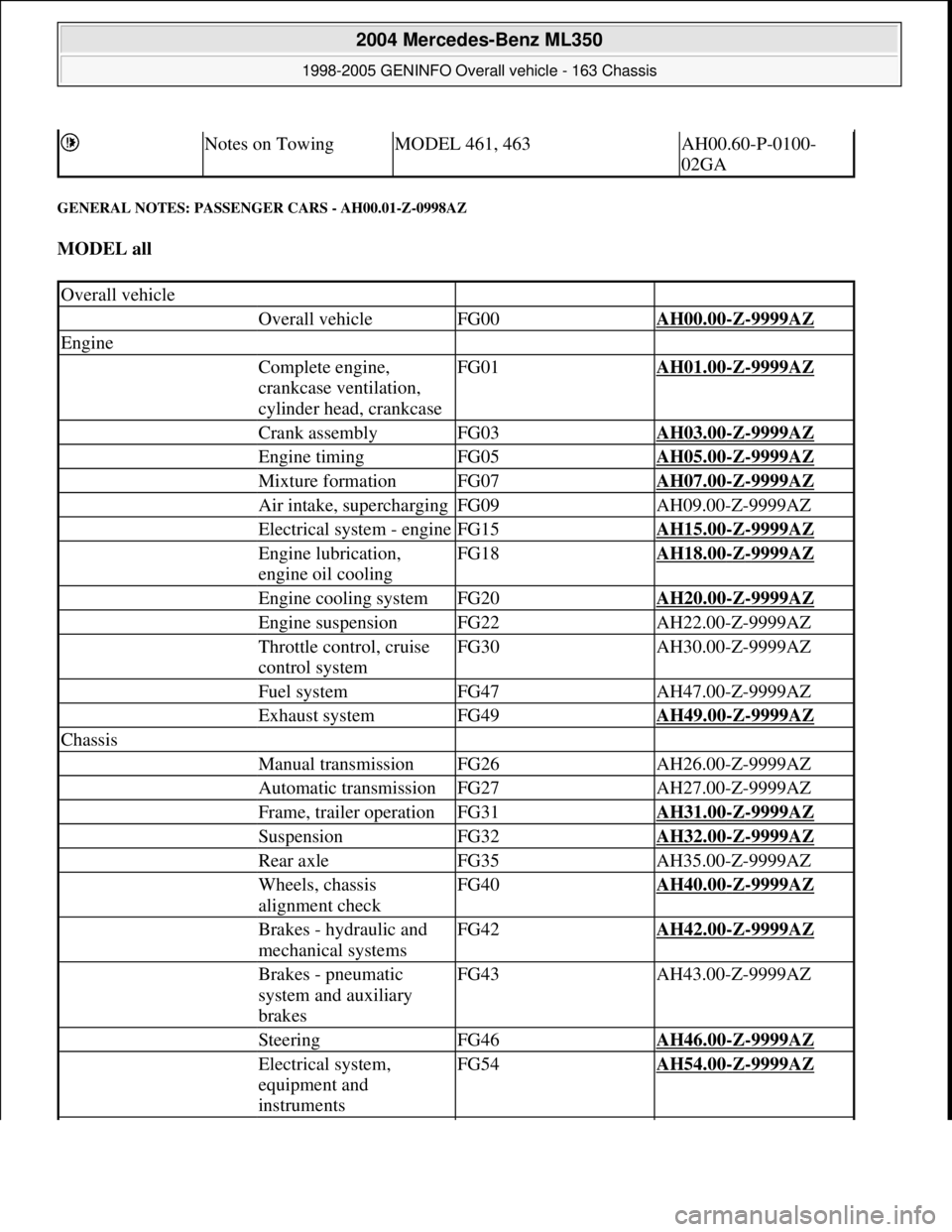
GENERAL NOTES: PASSENGER CARS - AH00.01-Z-0998AZ
MODEL all
Notes on TowingMODEL 461, 463AH00.60-P-0100-
02GA
Overall vehicle
Overall vehicleFG00AH00.00-Z-9999AZ
Engine
Complete engine,
crankcase ventilation,
cylinder head, crankcaseFG01AH01.00-Z-9999AZ
Crank assemblyFG03AH03.00-Z-9999AZ
Engine timingFG05AH05.00-Z-9999AZ
Mixture formationFG07AH07.00-Z-9999AZ
Air intake, superchargingFG09AH09.00-Z-9999AZ
Electrical system - engineFG15AH15.00-Z-9999AZ
Engine lubrication,
engine oil coolingFG18AH18.00-Z-9999AZ
Engine cooling systemFG20AH20.00-Z-9999AZ
Engine suspensionFG22AH22.00-Z-9999AZ
Throttle control, cruise
control systemFG30AH30.00-Z-9999AZ
Fuel systemFG47AH47.00-Z-9999AZ
Exhaust systemFG49AH49.00-Z-9999AZ
Chassis
Manual transmissionFG26AH26.00-Z-9999AZ
Automatic transmissionFG27AH27.00-Z-9999AZ
Frame, trailer operationFG31AH31.00-Z-9999AZ
SuspensionFG32AH32.00-Z-9999AZ
Rear axleFG35AH35.00-Z-9999AZ
Wheels, chassis
alignment checkFG40AH40.00-Z-9999AZ
Brakes - hydraulic and
mechanical systemsFG42AH42.00-Z-9999AZ
Brakes - pneumatic
system and auxiliary
brakesFG43AH43.00-Z-9999AZ
SteeringFG46AH46.00-Z-9999AZ
Electrical system,
equipment and
instrumentsFG54AH54.00-Z-9999AZ
2004 Mercedes-Benz ML350
1998-2005 GENINFO Overall vehicle - 163 Chassis
me
Saturday, October 02, 2010 3:47:44 PMPage 10 © 2006 Mitchell Repair Information Company, LLC.
Page 2862 of 4133
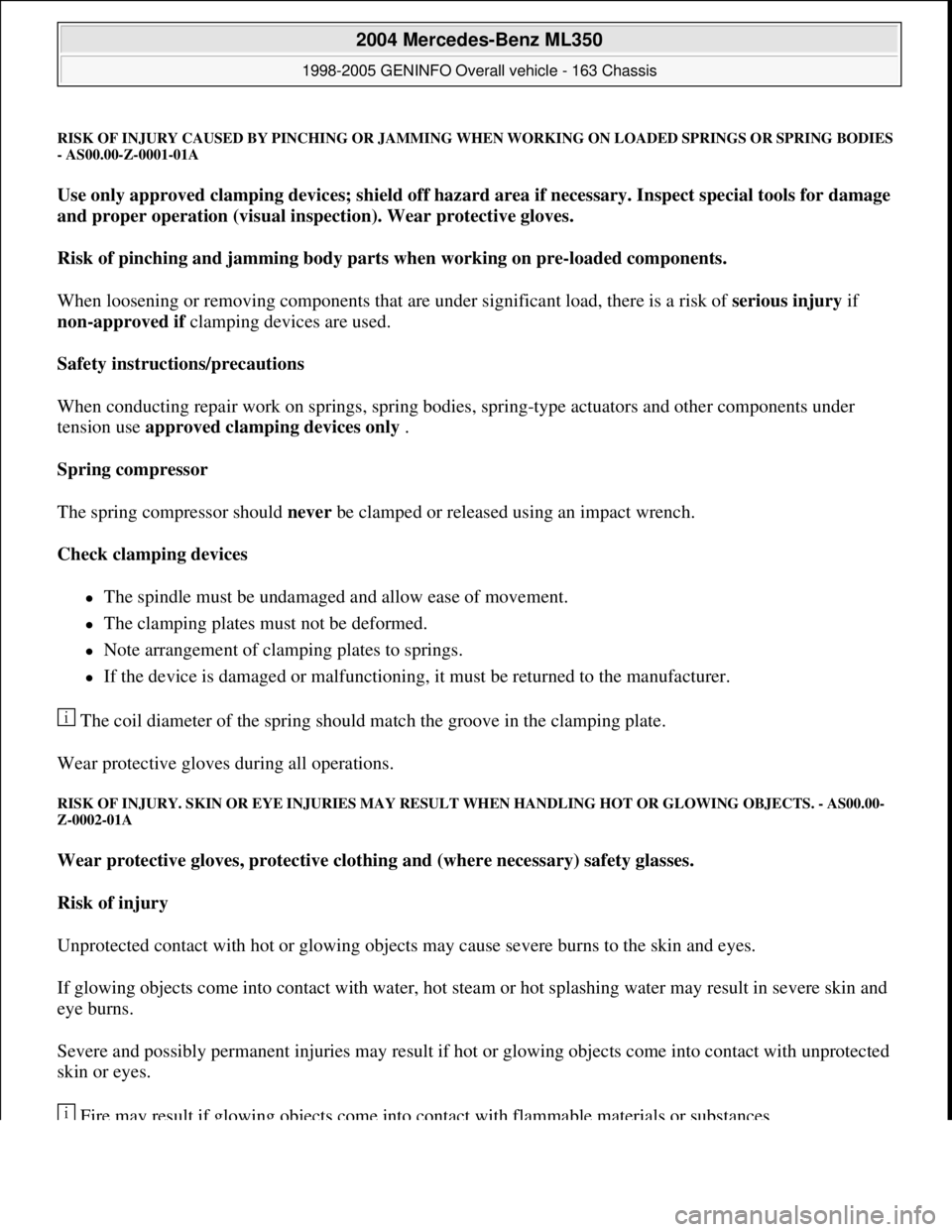
RISK OF INJURY CAUSED BY PINCHING OR JAMMING WHEN WORKING ON LOADED SPRINGS OR SPRING BODIES
- AS00.00-Z-0001-01A
Use only approved clamping devices; shield off hazard area if necessary. Inspect special tools for damage
and proper operation (visual inspection). Wear protective gloves.
Risk of pinching and jamming body parts when working on pre-loaded components.
When loosening or removing components that are under significant load, there is a risk of serious injury if
non-approved if clamping devices are used.
Safety instructions/precautions
When conducting repair work on springs, spring bodies, spring-type actuators and other components under
tension use approved clamping devices only .
Spring compressor
The spring compressor should never be clamped or released using an impact wrench.
Check clamping devices
The spindle must be undamaged and allow ease of movement.
The clamping plates must not be deformed.
Note arrangement of clamping plates to springs.
If the device is damaged or malfunctioning, it must be returned to the manufacturer.
The coil diameter of the spring should match the groove in the clamping plate.
Wear protective gloves during all operations.
RISK OF INJURY. SKIN OR EYE INJURIES MAY RESULT WHEN HANDLING HOT OR GLOWING OBJECTS. - AS00.00-
Z-0002-01A
Wear protective gloves, protective clothing and (where necessary) safety glasses.
Risk of injury
Unprotected contact with hot or glowing objects may cause severe burns to the skin and eyes.
If glowing objects come into contact with water, hot steam or hot splashing water may result in severe skin and
eye burns.
Severe and possibly permanent injuries may result if hot or glowing objects come into contact with unprotected
skin or eyes.
Fire ma
y result if glowing objects come into contact with flammable materials or substances.
2004 Mercedes-Benz ML350
1998-2005 GENINFO Overall vehicle - 163 Chassis
me
Saturday, October 02, 2010 3:47:47 PMPage 217 © 2006 Mitchell Repair Information Company, LLC.
Page 3046 of 4133
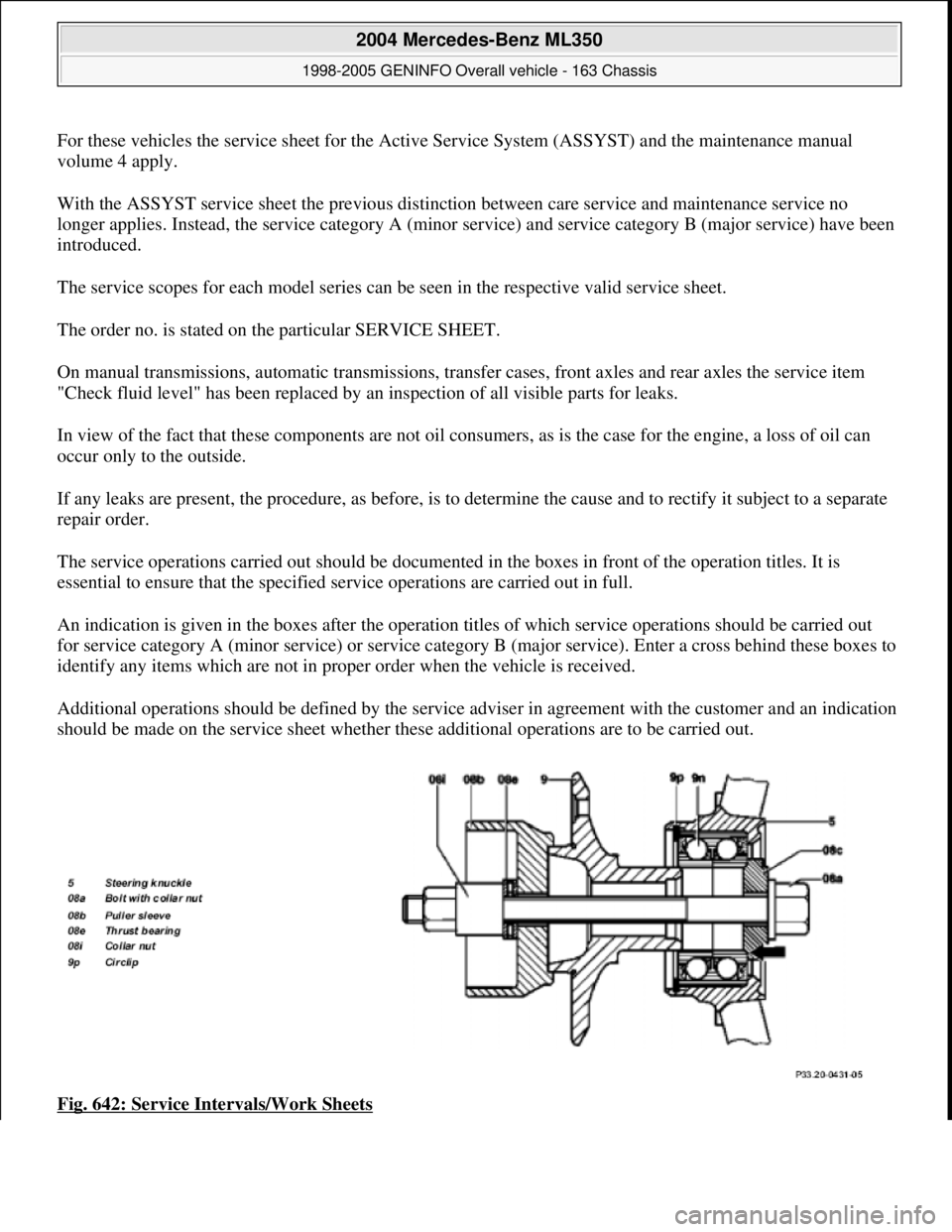
For these vehicles the service sheet for the Active Service System (ASSYST) and the maintenance manual
volume 4 apply.
With the ASSYST service sheet the previous distinction between care service and maintenance service no
longer applies. Instead, the service category A (minor service) and service category B (major service) have been
introduced.
The service scopes for each model series can be seen in the respective valid service sheet.
The order no. is stated on the particular SERVICE SHEET.
On manual transmissions, automatic transmissions, transfer cases, front axles and rear axles the service item
"Check fluid level" has been replaced by an inspection of all visible parts for leaks.
In view of the fact that these components are not oil consumers, as is the case for the engine, a loss of oil can
occur only to the outside.
If any leaks are present, the procedure, as before, is to determine the cause and to rectify it subject to a separate
repair order.
The service operations carried out should be documented in the boxes in front of the operation titles. It is
essential to ensure that the specified service operations are carried out in full.
An indication is given in the boxes after the operation titles of which service operations should be carried out
for service category A (minor service) or service category B (major service). Enter a cross behind these boxes to
identify any items which are not in proper order when the vehicle is received.
Additional operations should be defined by the service adviser in agreement with the customer and an indication
should be made on the service sheet whether these additional operations are to be carried out.
Fig. 642: Service Intervals/Work Sheets
2004 Mercedes-Benz ML350
1998-2005 GENINFO Overall vehicle - 163 Chassis
me
Saturday, October 02, 2010 3:47:52 PMPage 401 © 2006 Mitchell Repair Information Company, LLC.
Page 3049 of 4133
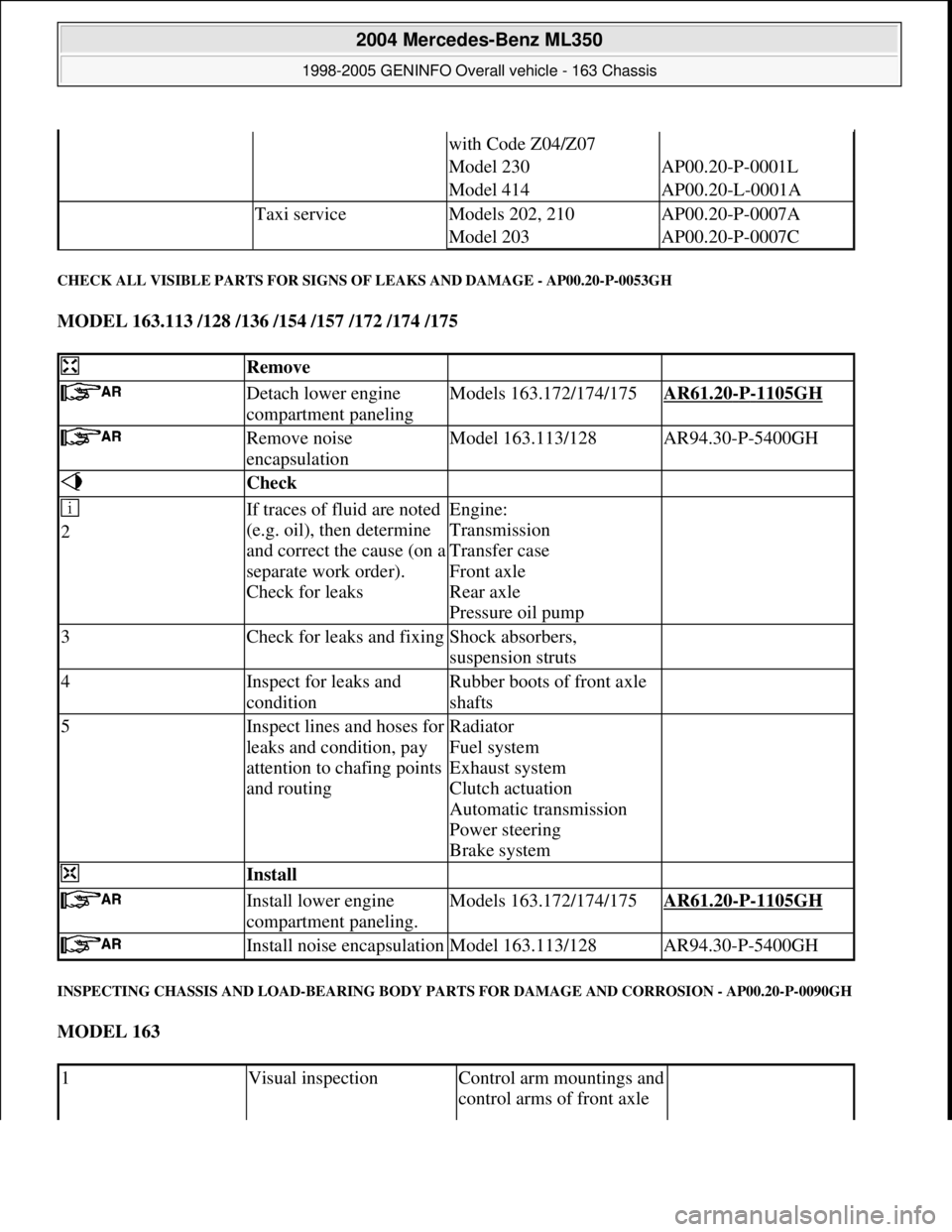
CHECK ALL VISIBLE PARTS FOR SIGNS OF LEAKS AND DAMAGE - AP00.20-P-0053GH
MODEL 163.113 /128 /136 /154 /157 /172 /174 /175
INSPECTING CHASSIS AND LOAD-BEARING BODY PARTS FOR DAMAGE AND CORROSION - AP00.20-P-0090GH
MODEL 163
with Code Z04/Z07
Model 230AP00.20-P-0001L
Model 414AP00.20-L-0001A
Taxi serviceModels 202, 210AP00.20-P-0007A
Model 203AP00.20-P-0007C
Remove
Detach lower engine
compartment panelingModels 163.172/174/175AR61.20-P-1105GH
Remove noise
encapsulationModel 163.113/128AR94.30-P-5400GH
Check
2If traces of fluid are noted
(e.g. oil), then determine
and correct the cause (on a
separate work order).
Check for leaksEngine:
Transmission
Transfer case
Front axle
Rear axle
Pressure oil pump
3Check for leaks and fixingShock absorbers,
suspension struts
4Inspect for leaks and
conditionRubber boots of front axle
shafts
5Inspect lines and hoses for
leaks and condition, pay
attention to chafing points
and routingRadiator
Fuel system
Exhaust system
Clutch actuation
Automatic transmission
Power steering
Brake system
Install
Install lower engine
compartment paneling.Models 163.172/174/175AR61.20-P-1105GH
Install noise encapsulationModel 163.113/128AR94.30-P-5400GH
1Visual inspectionControl arm mountings and
control arms of front axle
2004 Mercedes-Benz ML350
1998-2005 GENINFO Overall vehicle - 163 Chassis
me
Saturday, October 02, 2010 3:47:52 PMPage 404 © 2006 Mitchell Repair Information Company, LLC.
Page 3052 of 4133
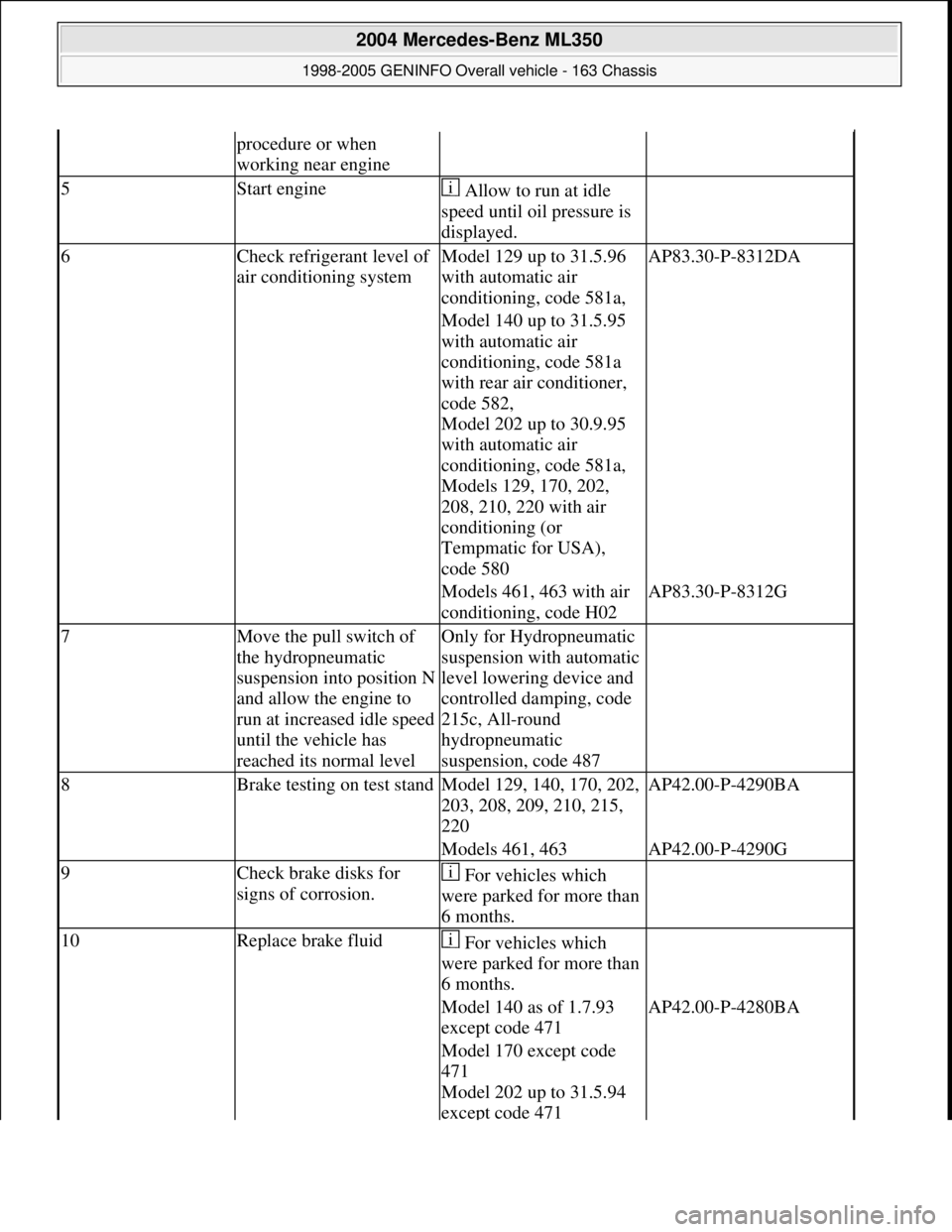
procedure or when
working near engine
5Start engine Allow to run at idle
speed until oil pressure is
displayed.
6Check refrigerant level of
air conditioning systemModel 129 up to 31.5.96
with automatic air
conditioning, code 581a,AP83.30-P-8312DA
Model 140 up to 31.5.95
with automatic air
conditioning, code 581a
with rear air conditioner,
code 582,
Model 202 up to 30.9.95
with automatic air
conditioning, code 581a,
Models 129, 170, 202,
208, 210, 220 with air
conditioning (or
Tempmatic for USA),
code 580
Models 461, 463 with air
conditioning, code H02AP83.30-P-8312G
7Move the pull switch of
the hydropneumatic
suspension into position N
and allow the engine to
run at increased idle speed
until the vehicle has
reached its normal levelOnly for Hydropneumatic
suspension with automatic
level lowering device and
controlled damping, code
215c, All-round
hydropneumatic
suspension, code 487
8Brake testing on test standModel 129, 140, 170, 202,
203, 208, 209, 210, 215,
220AP42.00-P-4290BA
Models 461, 463AP42.00-P-4290G
9Check brake disks for
signs of corrosion. For vehicles which
were parked for more than
6 months.
10Replace brake fluid For vehicles which
were parked for more than
6 months.
Model 140 as of 1.7.93
except code 471AP42.00-P-4280BA
Model 170 except code
471
Model 202 up to 31.5.94
except code 471
2004 Mercedes-Benz ML350
1998-2005 GENINFO Overall vehicle - 163 Chassis
me
Saturday, October 02, 2010 3:47:52 PMPage 407 © 2006 Mitchell Repair Information Company, LLC.
Page 3170 of 4133
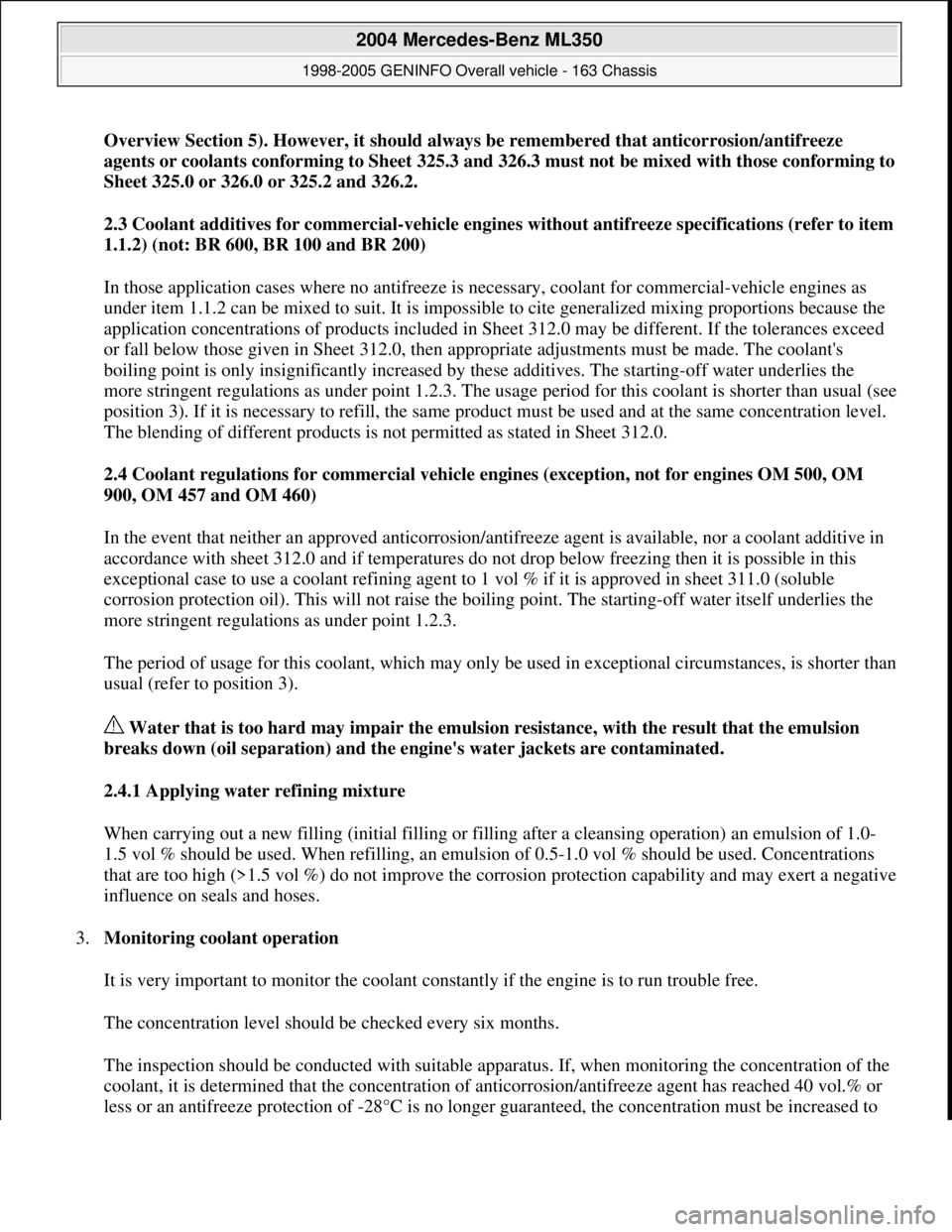
Overview Section 5). However, it should always be remembered that anticorrosion/antifreeze
a
gents or coolants conforming to Sheet 325.3 and 326.3 must not be mixed with those conforming to
Sheet 325.0 or 326.0 or 325.2 and 326.2.
2.3 Coolant additives for commercial-vehicle en
gines without antifreeze specifications (refer to item
1.1.2) (not: BR 600, BR 100 and BR 200)
In those application cases where no antifreeze is necessary, coolant for commercial-vehicle engines as
under item 1.1.2 can be mixed to suit. It is impossible to cite generalized mixing proportions because the
application concentrations of products included in Sheet 312.0 may be different. If the tolerances exceed
or fall below those given in Sheet 312.0, then appropriate adjustments must be made. The coolant's
boiling point is only insignificantly increased by these additives. The starting-off water underlies the
more stringent regulations as under point 1.2.3. The usage period for this coolant is shorter than usual (see
position 3). If it is necessary to refill, the same product must be used and at the same concentration level.
The blending of different products is not permitted as stated in Sheet 312.0.
2.4 Coolant regulations for commercial vehicle engines (exception, not for engines OM 500, OM
900, OM 457 and OM 460)
In the event that neither an approved anticorrosion/antifreeze agent is available, nor a coolant additive in
accordance with sheet 312.0 and if temperatures do not drop below freezing then it is possible in this
exceptional case to use a coolant refining agent to 1 vol % if it is approved in sheet 311.0 (soluble
corrosion protection oil). This will not raise the boiling point. The starting-off water itself underlies the
more stringent regulations as under point 1.2.3.
The period of usage for this coolant, which may only be used in exceptional circumstances, is shorter than
usual (refer to position 3).
Water that is too hard may impair the emulsion resistance, with the result that the emulsion
breaks down (oil separation) and the engine's water jackets are contaminated.
2.4.1 Applying water refining mixture
When carrying out a new filling (initial filling or filling after a cleansing operation) an emulsion of 1.0-
1.5 vol % should be used. When refilling, an emulsion of 0.5-1.0 vol % should be used. Concentrations
that are too high (>1.5 vol %) do not improve the corrosion protection capability and may exert a negative
influence on seals and hoses.
3.Monitoring coolant operation
It is very important to monitor the coolant constantly if the engine is to run trouble free.
The concentration level should be checked every six months.
The inspection should be conducted with suitable apparatus. If, when monitoring the concentration of the
coolant, it is determined that the concentration of anticorrosion/antifreeze agent has reached 40 vol.% or
less or an antifreeze protection of -28°C is no lon
ger guaranteed, the concentration must be increased to
2004 Mercedes-Benz ML350
1998-2005 GENINFO Overall vehicle - 163 Chassis
me
Saturday, October 02, 2010 3:47:57 PMPage 525 © 2006 Mitchell Repair Information Company, LLC.
Page 3185 of 4133

AD54.30-P-2000-02GC
Notes on HHT previous knowledge diagnosis
IC
HHT :
The instrument cluster and active service system (ASSYST) sub-
function are checked with HHT, there being the choice of the
following functions for this:
1. Control module version
2. Fault memory
3. Actual values
4. Actuations
5. Control module adaptation
Additional information on test items 2, 3 and 5 can be called up using
the INPUT key
Control module adaptation
The following alternatives are available in the HHT under control
module adaptation:
1.)
Read out coding and transfer to new instrument cluster. IC and
ASSYST.
2.)
Read out/change codings e.g.:
Engine and national variants,
version of fuel tank,
special equipment etc.
3.)
Settings:
1
Clock
2
Put forward kilometer reading
3
Put back kilometer reading
4
Oil change
5
Reset oil change initiated inadvertently
6
Active Service System
7
Enter times with battery disconnected
8
Set minimum oil warning
Before replacing a defective instrument cluster, readout the existing
variant codings (driving data and instrument cluster data) and store in
the HHT on an interim basis. Read in the values stored on an interim
basis again after installing the new instrument cluster.
If it is not possible to read out the stored variant coding, all variant
codings must be input manually (menu-assistance in HHT).
When installing an instrument cluster on an experimental basis, do
not put forward the kilometer reading as it cannot be put back later.
Copyright DaimlerChrysler AG 05.06.2006 CD-Ausgabe G/10/04 . This WIS print-out will not be recorde
d by Modification services.
Page 1
Page 3190 of 4133

AF18.00-P-8044D
High oil consumption
12.3.01
ENGINE
112 in MODEL 129, 163, 170, 202, 203, 208, 210, 220
ENGINE
113 in MODEL 129, 163, 202, 208, 210, 215, 220
ENGINE
112, 113 in MODEL 463
Damage code
Cause
Remedy
Studies on engines 112/113 due to
excessive engine oil consumption have
indicated to date that excessive engine oil
consumption is not a general subject, but
rather can result from various causes.
The causes listed below may cause
excessive engine oil consumption individually
or in combination.
For commercially available tools for see
Workshop Equipment Manual
Cause 1:
Remedy 1:
00 001 70
Cast iron crust in right cylinder head behind
oil drain opening
1
Remove cast iron crust
AF18.00-P-8045A
Cause 2:
Remedy 2:
00 001 70
V-shaped material flaws (rough unhoned
points) on individual cylinder liners
Up to production 08/2000.
1
Check cylinder liners with piston at
bottom dead center.
#
Inspect cylinders with light probe
AR01.00-P-0200AU
*WH58.30-Z-1009-05A
*WH58.30-Z-1010-05A
*WH58.30-Z-1027-05A
Cylinder barrels not okay:
#
2
Remove/install/replace engine or
shortblock.
Cause 3:
Remedy 3:
00 001 70
Single oil scraper rings with ring tension at
lower tolerance limit.
Up to production 06/1999.
1
Perform oil consumption test drive over
approx. 500 km.
AR18.00-P-0025AV
Exclude all other types of faults.
2
Remove/install/replace piston rings.
Install cleaned pistons with new piston
rings in the same cylinder.
Install piston rings with optimized ring
tension.
These piston rings are available as
replacement parts under the normal
replacement part number.
Cause 4:
Remedy 4:
00 001 70
Individual (right) cylinder heads with inner
porous points to air injection duct.
1
Check left/right cylinder bank.
If a cylinder bank is oily:
#
2
Remove/install/replace only this cylinder
head.
ENGINE
112 in MODEL 220, 210, 208, 202,
129
ENGINE
113 in MODEL 220, 210, 208, 202,
129
AR01.30-P-5800B
ENGINE
112.942 in MODEL 163.154
ENGINE
113.942 in MODEL 163.172
ENGINE
113.981 in MODEL 163.174 AR01.30-P-5800MV
ENGINE
112.945, 113.962 in MODEL 463
AR01.30-P-5800GV
Cause 5:
Remedy 5:
00 001 70
Individual engines with missing valve seals on
individual cylinders
1
Remove valve springs on affected
cylinder.
AR05.30-P-3500B
In this case, usually one cylinder is oily, oil
runs through valve cone into cylinder when
valve is open.
2
Check valve seal.
Copyright DaimlerChrysler AG 20.05.2006 CD-Ausgabe G/10/04 . This WIS print-out will not be recorde
d by Modification services.
Page 1